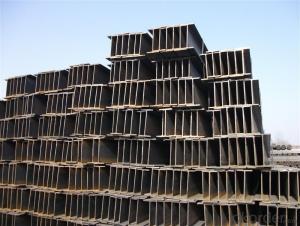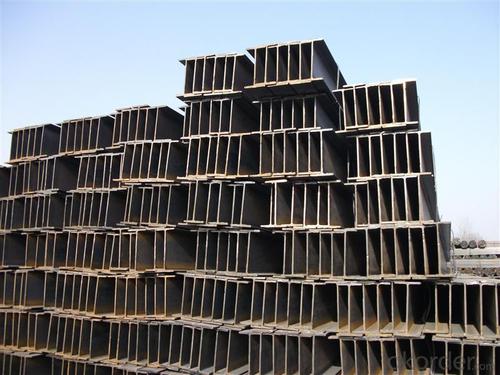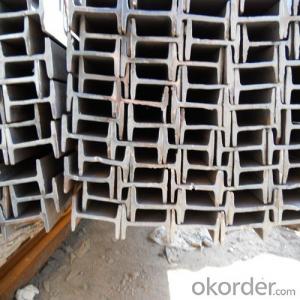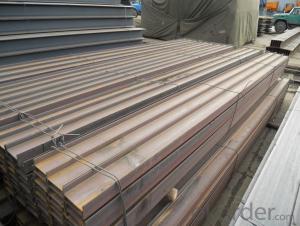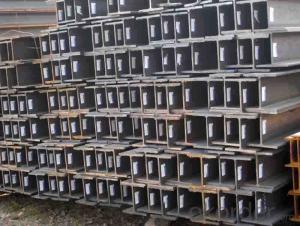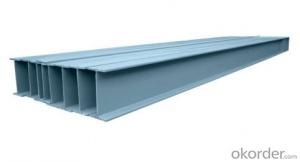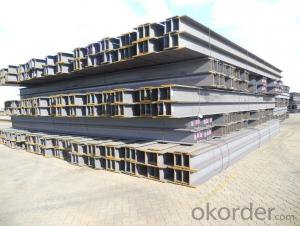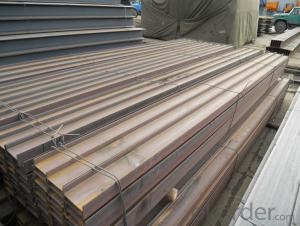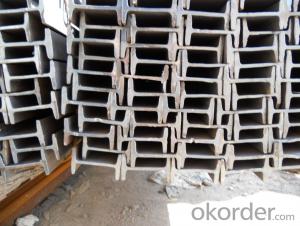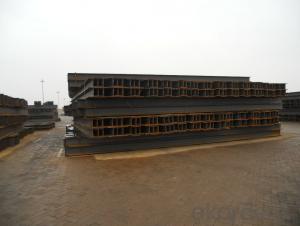Hot rolled steel H beams for sale
- Loading Port:
- Shanghai
- Payment Terms:
- TT OR LC
- Min Order Qty:
- 25 m.t.
- Supply Capability:
- 30000 m.t./month
OKorder Service Pledge
OKorder Financial Service
You Might Also Like
Specifications of Hot Rolled Structural Steel H Beam
1. Standard: GB700-88, Q235B2.
2. Grade: Q235, SS400 or Equivalent
3. Length: 6m,10m, 12m as following table
4. Invoicing on theoretical weight or actual weight as customer request
5.Payment: TT or L/C
6. Sizes:
SIZE(mm) | DIMENSION(kg/m) |
100*100 | 16.9 |
125*125 | 23.6 |
150*75 | 14 |
150*150 | 31.1 |
148*100 | 20.7 |
198*99 | 17.8 |
200*100 | 20.9 |
248*124 | 25.1 |
250*125 | 29 |
Usage & Applications of Hot Rolled Structural Steel H Beam
Commercial building structure ;Pre-engineered buildings; Machinery support structure; Prefabricated structure; Medium scale bridges; Ship-building structure. etc.
Packaging & Delivery of Hot Rolled Structural Steel H Beam
1. Packing: it is nude packed in bundles by steel wire rod
2. Bundle weight: not more than 3.5MT for bulk vessel; less than 3 MT for container load
3. Marks:
Color marking: There will be color marking on both end of the bundle for the cargo delivered by bulk vessel. That makes it easily to distinguish at the destination port.
Tag mark: there will be tag mark tied up on the bundles. The information usually including supplier logo and name, product name, made in China, shipping marks and other information request by the customer.
If loading by container the marking is not needed, but we will prepare it as customer request.
4. Transportation: the goods are delivered by truck from mill to loading port, the maximum quantity can be loaded is around 40MTs by each truck. If the order quantity cannot reach the full truck loaded, the transportation cost per ton will be little higher than full load.
5. Delivered by container or bulk vessel
Production flow of Hot Rolled Structural Steel H Beam
Material prepare (billet) —heat up—rough rolling—precision rolling—cooling—packing—storage and transportation
- Q: How do steel H-beams contribute to energy-efficient lighting design?
- Steel H-beams contribute to energy-efficient lighting design by providing a strong and durable support structure for lighting fixtures. These beams allow for strategic placement of lights, ensuring optimal illumination and minimizing energy wastage. Additionally, the H-beams can be designed to accommodate wiring and fixtures, enabling efficient installation and maintenance of lighting systems.
- Q: Are Steel H-Beams suitable for multi-story buildings?
- Indeed, steel H-beams prove to be a fitting choice for constructing multi-story buildings. Frequently referred to as I-beams, H-beams are widely utilized in the field of construction due to their robustness, adaptability, and affordability. The distinctive H shape of these beams allows for remarkable load-bearing capability, thereby enabling the creation of towering and roomy structures. In particular, steel H-beams possess the capacity to bear hefty loads and efficiently transfer them to the foundation, rendering them highly suitable for multi-story buildings. Furthermore, steel as a material exhibits durability by effectively withstanding fire, corrosion, and pests, thereby ensuring the structure's longevity and safety.
- Q: How are steel H-beams protected against corrosion during construction?
- Steel H-beams are protected against corrosion during construction through various methods such as galvanization, painting, or applying protective coatings. These measures create a barrier between the steel surface and the surrounding environment, preventing moisture, oxygen, and other corrosive agents from coming into direct contact with the steel, thus minimizing the risk of corrosion.
- Q: Can steel H-beams be used for agricultural buildings?
- Yes, steel H-beams can be used for agricultural buildings. Steel H-beams are commonly used in construction due to their strength, durability, and versatility. They can provide excellent structural support for agricultural buildings such as barns, sheds, or storage facilities. Steel H-beams can withstand heavy loads and provide resistance against weather elements such as wind, snow, and rain. Additionally, steel is a non-combustible material, making it a safer choice for agricultural buildings. The flexibility of steel allows for various design options and modifications to meet specific agricultural needs. Overall, steel H-beams are a reliable and efficient choice for constructing sturdy agricultural buildings.
- Q: How do steel H-beams contribute to the overall sound insulation of a building?
- Steel H-beams do not directly contribute to the overall sound insulation of a building. Sound insulation primarily depends on the materials used for walls, floors, and ceilings, as well as the construction techniques employed. However, steel H-beams can indirectly affect sound insulation in a building in a few ways. Firstly, they provide structural support to the building, ensuring stability and preventing vibrations. This can help minimize the transmission of sound caused by vibrations from external sources, such as traffic or machinery, into the building. Additionally, steel H-beams can be used in the construction of suspended ceilings or raised floors, which are often designed to enhance sound insulation. These components can incorporate insulation materials, such as mineral wool or acoustic mats, that help to absorb sound and reduce its transmission between different areas of the building. Furthermore, steel H-beams can be utilized in the construction of partition walls, which can play a role in sound insulation between different rooms or units within a building. By providing a sturdy framework, H-beams can support soundproofing materials, such as dense gypsum boards or acoustic panels, which effectively reduce sound transmission. While steel H-beams themselves do not directly contribute to sound insulation, their use in building construction can support the implementation of soundproofing measures and enhance the overall acoustic performance of a building.
- Q: How do Steel H-Beams contribute to the overall daylighting or natural lighting of a structure?
- Steel H-Beams do not directly contribute to the overall daylighting or natural lighting of a structure. Instead, their primary function is to provide structural support and stability to the building. These beams are commonly used in construction projects to bear heavy loads, such as the weight of floors, walls, and roofs. Daylighting or natural lighting in a structure refers to the use of natural light to illuminate the interior spaces, reducing the need for artificial lighting during the daytime. Several architectural elements and design strategies are employed to optimize the entry of natural light into a building, such as the use of large windows, skylights, light shelves, and light tubes. While Steel H-Beams do not directly contribute to daylighting, they indirectly play a role in supporting the architectural elements that facilitate natural lighting. These beams provide the necessary framework and structural integrity for the installation of large windows, skylights, and other elements that maximize the entry of natural light into the building. By offering a robust support system, Steel H-Beams enable architects and engineers to design buildings with larger openings for windows and skylights, allowing for more natural light to penetrate the interior spaces. Therefore, although Steel H-Beams may not directly contribute to daylighting or natural lighting, they are crucial in creating a structural framework that supports the architectural elements responsible for maximizing the entry of natural light into a structure.
- Q: How long do steel H-beams last?
- Depending on factors such as the quality of the steel, usage conditions, and maintenance practices, steel H-beams have the ability to last for multiple decades, and in some cases, even longer. The durability and longevity of steel H-beams are well-known due to the inherent strength and resilience of steel as a material. With proper care and maintenance, which includes regular inspections, addressing any signs of corrosion, and protecting them from moisture or extreme weather conditions, steel H-beams can maintain their structural integrity for a significant amount of time. However, it should be noted that the lifespan of steel H-beams can vary depending on the specific purpose and load-bearing requirements. To obtain more accurate and detailed information based on the specific circumstances, it is advisable to consult with a structural engineer or a professional in the construction industry.
- Q: What's the difference between I-beam and H steel?
- H steel is a kind of economical section steel with better mechanical properties than I-beam. Its shape is named after its English letter "H". The flange of hot rolled H steel is wider than that of I-beam, big lateral rigidity and strong bending resistance. Under the same specifications, H steel is lighter than i-beam.
- Q: Can steel H-beams be used in parking garage construction?
- Yes, steel H-beams can indeed be used in parking garage construction. They are commonly used as structural supports due to their high strength and load-bearing capacity. Their versatility and ability to withstand heavy loads make them an ideal choice for constructing parking garages, where the need for a strong and durable framework is crucial.
- Q: Can steel H-beams be used for sports arenas?
- Sports arenas can indeed utilize steel H-beams. These beams are widely employed in the construction field because of their impressive strength, durability, and capacity to bear heavy loads. Given that sports arenas often necessitate spacious interiors and lofty ceilings, steel H-beams possess the necessary structural support required for such designs. Furthermore, the fabrication and assembly of steel H-beams are straightforward, rendering them a cost-efficient option for constructing sports arenas. Additionally, steel exhibits resistance against fire, pests, and natural elements, rendering it a dependable material for long-term usage in sports arenas. All in all, the robustness, versatility, and cost-effectiveness of steel H-beams make them a fitting choice for the construction of sports arenas.
Send your message to us
Hot rolled steel H beams for sale
- Loading Port:
- Shanghai
- Payment Terms:
- TT OR LC
- Min Order Qty:
- 25 m.t.
- Supply Capability:
- 30000 m.t./month
OKorder Service Pledge
OKorder Financial Service
Similar products
Hot products
Hot Searches
Related keywords
